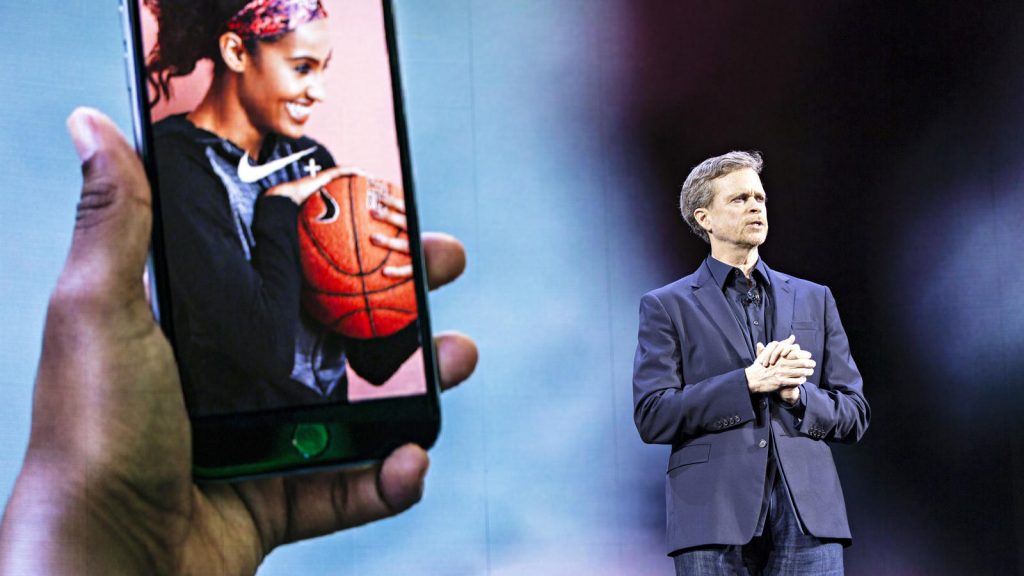On its third-quarter conference call, Mark Parker, president and CEO, Nike Inc., said the company plans to double down on its investments in “getting sharper and moving faster” because of how digital is transforming the retail marketplace.
The digital shift was the big story over the recent holiday selling season, and Parker stated that the shift has “accelerated” over the last 90 days.
“The consumer has decided digital isn’t just a part of the shopping experience,” said Parker. “Digital is the foundation of it. This and other factors have shifted consumer patterns, especially in North America, impacting traffic, the economics of brick-and-mortar retail and is driving a more promotional environment in the near term.”
As a result, he said that while the company continues to invest and make progress in three key areas – innovation, supply chain and marketplace – Nike is now “committed to doubling our impact in each of them” in light of consumers’ recent rising expectations. He added, “We call it our triple double.”
He continued, “In products, Nike we’re doubling our cadence and scale of innovation through performance and sports style. Throughout our supply chain, we are doubling our speed, from product insight to delivery to the consumer, and in the marketplace, we’re doubling our direct connections with consumers through digital membership and personalization. To win now and create the future, we’re obsessing these three areas, 2X innovation, 2X speed and 2X direct.”
Around innovation, the focus is on “shifting to an even faster innovation cycle and scaling more effectively. Our consumers will feel the impact of this immediately.”
The success of its Air VaporMax cushioning platform will be quickly scaled to new models. A second major cushioning platform arrives in early June with the Nike Zoom VaporFly 4%, which has a goal of breaking the two-hour marathon. Parker said the model has witnessed “off the charts” feedback from athletes. Stated Parker, “As a former marathoner, I know that even a 1 percent gain would be an impressive accomplishment. But over our previous best shoe, this delivers an astronomical 4 percent gain in efficiency.”
Later this summer, a third cushioning system arrives with new materials to help runners and basketball players “increase their performance and stay fresh, longer.”
Summed up Parker, “That’s three new cushioning platforms coming to market in the months ahead. As our consumers will soon see – this is a cushioning revolution from Nike.”
In apparel, Parker sees a “huge untapped commercial opportunity” in addressing NBA styling “way beyond the court.” Further advancements and leveraging of its Hyperadapt 1.0, FlyEase and Flyknit technologies are also planned.
Around the supply chain, Nike plans to cut its average product creation cycle in half. Particularly beneficial has been a process called Express Lane, which lets its global product teams make real-time adjustments to DTC and wholesale product lines with local teams in North America, Western Europe and China. Said Parker, “We’re moving faster than ever before, getting products to market in weeks not months. Through the Express Lane, we’re fueling consumer demand through new localized styles.”
The speed will give Nike the ability to more quickly turn around delivery on some of its top sellers like the Air Pegasus and Air Force 1.
Though its partnerships such as with Flex, Nike is expanding into more styles with advanced automation in the build and adhesion processes, localizing sourcing for quicker material lead time and reducing waste through advanced knitting and higher precision cutting technologies. Said Parker, “We’re seeing a positive impact to gross margins in the tens of millions and we expect that to continue to accelerate.”
At the same time, manufacturing is being more closely aligned with real-time consumer insights, seamless inventory and a hyper-local marketplace approach.
Finally, Parker admitted that its Edit-to-Amplify approach has “not been as sharp as we need to be.” Currently 75 percent of its styles generate 99 percent of sales. By editing out 25 percent and amplifying the productivity of new innovations and stronger sellers, Nike expects to drive more growth and choice from fewer styles.
“We’re already seeing positive near-term returns from our work here,” said Parker. “Edit-to-Amplify is a mindset that reaches well beyond product. It’s about prioritizing every step along the way, from the category to geos (geographies) to cities, to accounts, all the way down to the door level.”
Doubling down on the marketplace involves better leveraging digital connections with consumers “to bring the Nike brand closer to them, regardless of whether they are in our own DTC or with wholesale partners.”
Parker noted, for example, that Nike Plus members who use its personnel shopping appointments generate more than three times the average transaction size. Nike is also seeing the consumer shift within digital commerce as well, with a larger share of the brand’s growth coming through its apps.
“It’s further confirmation that the consumer responds to a simpler, faster and more personal connection,” said Parker. “And right now that level of service, that deeper experience with the Nike brand is driving growth in our own DTC.”
Moving forward, however, its DTC successes, such as strong consumer response seen to the hyper-personalized approach of its new Soho store, will be shared with its own wholesale partners around the world.
“The more directly Nike engages with the consumer, the greater the return,” said Parker. “We’ve seen it with our strategic partners in key accounts, such as Foot Locker, Dick’s, JD, Intersport and TMall, where we’ve grown our businesses together, despite the uneven environment. And for those partners who align with our more direct approach to the consumer, we have an opportunity to leverage the Express Lane even more.”
Parker said the company doesn’t “expect this transition to be simple,” but he’s convinced that digital and personalized service will define tomorrow’s winners. Said Parker. “More personnel, more mobile, more distinctive, these are the dimensions that will drive growth. And I’m convinced now is the time to rewrite the playbook of retail.”
Photo courtesy Nike
















